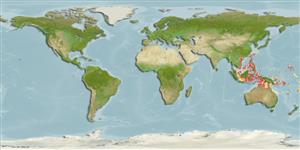Teleostei (teleosts) >
Gobiiformes (Gobies) >
Gobiidae (Gobies) > Gobiinae
Etymology: Valenciennea: From Achille Valenciennes 1794-1865; he worked with Duméril, Cuvier and Lacepède since 1815; malacologist, author of a "Histoire naturelle des poissons" (Ref. 45335).
More on authors: Hoese & Larson.
Environment: milieu / climate zone / depth range / distribution range
Ecology
Marine; demersal; depth range 12 - 35 m (Ref. 90102). Tropical
Western Pacific: Okinawa, Japan and the Philippines.
Size / Weight / Age
Maturity: Lm ? range ? - ? cm
Max length : 6.9 cm SL male/unsexed; (Ref. 8527)
Dorsal
spines
(total): 6 - 7;
Dorsal
soft rays
(total): 14-15;
Anal
spines: 1;
Anal
soft rays: 14 - 15. Characterized by pale grey body color with yellowish snout; 2-3 blue stripes on cheek; dorsal fin with yellow filaments; adult male has black throat and mouth; second to fourth dorsal spines produced into prolonged filaments in adult; rhomboid caudal fin; caudal length 2.8-3.4 in SL; longitudinal scale series 76-81; ctenoid body scales except cycloid on abdomen; head or midline of nape without scales; cycloid scales extending forward on side of nape to above middle of operculum in adult; scaled pectoral fin base and prepelvic area; depth of body 4.7-5.1 in SL (Ref. 90102).
Occurs in areas with rubble, rock and sand bottoms of coastal reefs in 12-35 m. Solitary or in pairs (Ref. 90102). Feeds on small invertebrates particularly copepods.
Life cycle and mating behavior
Maturity | Reproduction | Spawning | Eggs | Fecundity | Larvae
Hoese, D.F. and H.K. Larson, 1994. Revision of the Indo-Pacific gobiid fish genus Valenciennea, with descriptions of seven new species. Indo-Pac. Fish. (23):71 p. (Ref. 8527)
IUCN Red List Status (Ref. 130435)
Threat to humans
Harmless
Human uses
More information
Common namesSynonymsMetabolismPredatorsEcotoxicologyReproductionMaturitySpawningSpawning aggregationFecundityEggsEgg development
ReferencesAquacultureAquaculture profileStrainsGeneticsElectrophoresesHeritabilityDiseasesProcessingNutrientsMass conversion
Tools
Special reports
Download XML
Internet sources
Estimates based on models
Preferred temperature (Ref.
123201): 27.1 - 29.1, mean 28.1 °C (based on 58 cells).
Phylogenetic diversity index (Ref.
82804): PD
50 = 0.5000 [Uniqueness, from 0.5 = low to 2.0 = high].
Bayesian length-weight: a=0.00708 (0.00333 - 0.01504), b=3.09 (2.92 - 3.26), in cm total length, based on LWR estimates for this (Sub)family-body shape (Ref.
93245).
Trophic level (Ref.
69278): 3.0 ±0.00 se; based on food items.
Resilience (Ref.
120179): High, minimum population doubling time less than 15 months (Preliminary K or Fecundity.).
Fishing Vulnerability (Ref.
59153): Low vulnerability (10 of 100).
